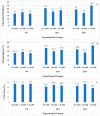Investigation of the Influence of Polyamines on Mature Embryo Culture and DNA Methylation of Wheat (Triticum aestivum L.) Using the Machine Learning Algorithm Method
- PMID: 37765424
- PMCID: PMC10536335
- DOI: 10.3390/plants12183261
Investigation of the Influence of Polyamines on Mature Embryo Culture and DNA Methylation of Wheat (Triticum aestivum L.) Using the Machine Learning Algorithm Method
Abstract
Numerous factors can impact the efficiency of callus formation and in vitro regeneration in wheat cultures through the introduction of exogenous polyamines (PAs). The present study aimed to investigate in vitro plant regeneration and DNA methylation patterns utilizing the inter-primer binding site (iPBS) retrotransposon and coupled restriction enzyme digestion-iPBS (CRED-iPBS) methods in wheat. This investigation involved the application of distinct types of PAs (Put: putrescine, Spd: spermidine, and Spm: spermine) at varying concentrations (0, 0.5, 1, and 1.5 mM). The subsequent outcomes were subjected to predictive modeling using diverse machine learning (ML) algorithms. Based on the specific polyamine type and concentration utilized, the results indicated that 1 mM Put and Spd were the most favorable PAs for supporting endosperm-associated mature embryos. Employing an epigenetic approach, Put at concentrations of 0.5 and 1.5 mM exhibited the highest levels of genomic template stability (GTS) (73.9%). Elevated Spd levels correlated with DNA hypermethylation while reduced Spm levels were linked to DNA hypomethylation. The in vitro and epigenetic characteristics were predicted using ML techniques such as the support vector machine (SVM), extreme gradient boosting (XGBoost), and random forest (RF) models. These models were employed to establish relationships between input variables (PAs, concentration, GTS rates, Msp I polymorphism, and Hpa II polymorphism) and output parameters (in vitro measurements). This comparative analysis aimed to evaluate the performance of the models and interpret the generated data. The outcomes demonstrated that the XGBoost method exhibited the highest performance scores for callus induction (CI%), regeneration efficiency (RE), and the number of plantlets (NP), with R2 scores explaining 38.3%, 73.8%, and 85.3% of the variances, respectively. Additionally, the RF algorithm explained 41.5% of the total variance and showcased superior efficacy in terms of embryogenic callus induction (ECI%). Furthermore, the SVM model, which provided the most robust statistics for responding embryogenic calluses (RECs%), yielded an R2 value of 84.1%, signifying its ability to account for a substantial portion of the total variance present in the data. In summary, this study exemplifies the application of diverse ML models to the cultivation of mature wheat embryos in the presence of various exogenous PAs and concentrations. Additionally, it explores the impact of polymorphic variations in the CRED-iPBS profile and DNA methylation on epigenetic changes, thereby contributing to a comprehensive understanding of these regulatory mechanisms.
Keywords: DNA methylation; genomic template stability; iPBS; machine learning.
Conflict of interest statement
The authors declare no conflict of interest.
Figures




Similar articles
-
Machine Learning Analysis of the Impact of Silver Nitrate and Silver Nanoparticles on Wheat (Triticum aestivum L.): Callus Induction, Plant Regeneration, and DNA Methylation.Plants (Basel). 2023 Dec 13;12(24):4151. doi: 10.3390/plants12244151. Plants (Basel). 2023. PMID: 38140479 Free PMC article.
-
Effects of Zinc, Copper and Iron Oxide Nanoparticles on Induced DNA Methylation, Genomic Instability and LTR Retrotransposon Polymorphism in Wheat (Triticum aestivum L.).Plants (Basel). 2022 Aug 24;11(17):2193. doi: 10.3390/plants11172193. Plants (Basel). 2022. PMID: 36079574 Free PMC article.
-
Polyamine and Its Metabolite H2O2 Play a Key Role in the Conversion of Embryogenic Callus into Somatic Embryos in Upland Cotton (Gossypium hirsutum L.).Front Plant Sci. 2015 Dec 2;6:1063. doi: 10.3389/fpls.2015.01063. eCollection 2015. Front Plant Sci. 2015. PMID: 26697030 Free PMC article.
-
Polyamines and cellular metabolism in plants: transgenic approaches reveal different responses to diamine putrescine versus higher polyamines spermidine and spermine.Amino Acids. 2010 Feb;38(2):405-13. doi: 10.1007/s00726-009-0399-4. Epub 2009 Dec 3. Amino Acids. 2010. PMID: 19956999 Review.
-
Thirty years of polyamine-related approaches to cancer therapy. Retrospect and prospect. Part 2. Structural analogues and derivatives.Curr Drug Targets. 2003 Oct;4(7):565-85. doi: 10.2174/1389450033490876. Curr Drug Targets. 2003. PMID: 14535655 Review.
Cited by
-
Leveraging machine learning to unravel the impact of cadmium stress on goji berry micropropagation.PLoS One. 2024 Jun 13;19(6):e0305111. doi: 10.1371/journal.pone.0305111. eCollection 2024. PLoS One. 2024. PMID: 38870239 Free PMC article.
-
Influence of exogenous polyamines on the secondary somatic embryogenesis of cork oak (Quercus suber L.).Bioengineered. 2023 Dec;14(1):2288354. doi: 10.1080/21655979.2023.2288354. Epub 2023 Nov 29. Bioengineered. 2023. PMID: 38031347 Free PMC article.
-
Putrescine treatment has a higher effect on 5mC DNA methylation profile of wheat leaves under white than under blue light conditions.Sci Rep. 2025 Jul 2;15(1):22734. doi: 10.1038/s41598-025-08184-y. Sci Rep. 2025. PMID: 40596608 Free PMC article.
References
-
- Kapoor R.T. Role of polyamines in plants under abiotic stresses: Regulation of biochemical interactions. Plant Stress Mitigators. 2023:209–220. doi: 10.1016/B978-0-323-89871-3.00023-9. - DOI
-
- Aydin M., Pour A.H., Haliloğlu K., Tosun M. Effect of polyamines on somatic embryogenesis via mature embryo in wheat. Turk. J. Biol. 2016;40:1178–1184. doi: 10.3906/biy-1601-21. - DOI
LinkOut - more resources
Full Text Sources
Research Materials
Miscellaneous

